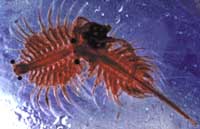Great Salt Lake Trivia Questions
By Mark Milligan
Here are three trivia questions related to Great Salt Lake. Can you answer them?
1. What do Great Salt Lake, the Bahamas, the old Hansen Planetarium in downtown Salt Lake City, the Manti LDS Temple, and Hearst Castle in San Simeon, California, have in common? Click here for answer!
Answer: OOIDS!
Ooids are small, rounded, sand-sized grains composed of concentric layers of calcium carbonate precipitated around a nucleus, and they form in shallow, wave-agitated water. The resulting deposit is said to be oolitic.
Great Salt Lake and the Bahamas have oolitic sand beaches, and the old Hansen Planetarium, the Manti LDS Temple, and Hearst Castle incorporate oolitic building stone.
The buildings all utilize oolitic limestone of the Green River Formation. This unusual stone was deposited in a large lake during the Eocene Epoch, approximately 55 to 38 million years ago.
2. What does the original Saltair resort on the south shore of Great Salt Lake have in common with the coasts of Indonesia, Thailand, and northwestern Malaysia? Click here for answer!
Answer: EARTHQUAKE GENERATED WAVES!
The coasts of Indonesia, Thailand, and northwestern Malaysia were all hit by the devastating tsunamis generated by a magnitude 9.1 earthquake under the Indian Ocean in December 2004.
Similarly, in 1909 an estimated magnitude 6 earthquake near the north arm of Great Salt Lake generated a wave that damaged the original Saltair resort and overtopped the old wooden railroad trestle that crossed the lake. This trestle was 12 feet above lake level, suggesting the wave was at least that high.
The wave in Great Salt Lake (technically a “seiche”) differed somewhat from the Indian Ocean tsunamis in that it resulted from ground shaking in a closed basin rather than fault rupture and offset of the seafloor.
3. What two things do Great Salt Lake, Apollo 16, and northern shovelers and common goldeneyes (ducks) have in common? Click here for answer!
Answer: BRINE SHRIMP and MERCURY!
On Sept. 29, 2005, high mercury levels prompted the Utah Department of Health to issue a waterfowl consumption advisory recommending people not eat these two duck species. The high mercury levels are believed to be due to the ducks’ consumption of brine shrimp from Great Salt Lake.
Brine shrimp eggs were used in an experiment on the effects of cosmic radiation, conducted by Apollo 16 astronauts on their way to the moon. Apollo 16’s “primitive” electronics presumably contained mercury as well.
Survey Notes, v. 39 no. 1, January 2007








